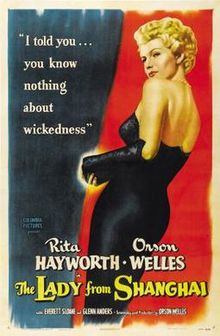This evening’s (July 24th) screening of John Ford’s 1962 classic The Man Who Shot Liberty Valance will be preceded by a lecture from the University of Virginia’s Dr. Carmenita  Higginbotham. This will mark the fifth occasion that Dr. Higginbotham has participated in this series (and we hope there will be many more occasions to come!) Having had an opportunity to sit in on each lecture, I am always astonished at what I learn. While I hardly profess to be a “movie buff,” I have seen a fair share of “classics” – those films comprising the canon of cinematography. But I saw them through very different eyes until a couple of years ago. I was a passive observer, spellbound by a story. Perhaps what most impresses me is the variety of techniques a director can employ to tell that story. Many of these techniques were first brought to my attention by Dr. Higginbotham. Take the famous hall of mirrors sequence in The Lady from Shanghai – a dizzying and unprecedented cinematographic feat, or the low-level shots throughout Hitchcock’s Notorious. Take the widescreen panoramic shots in All Quiet on the Western Front, or the uncomfortably close shots in the gritty Angels with Dirty Faces. The camera work: sometimes subtle, sometimes grossly exaggerated and making little effort to conceal an effect.
Higginbotham. This will mark the fifth occasion that Dr. Higginbotham has participated in this series (and we hope there will be many more occasions to come!) Having had an opportunity to sit in on each lecture, I am always astonished at what I learn. While I hardly profess to be a “movie buff,” I have seen a fair share of “classics” – those films comprising the canon of cinematography. But I saw them through very different eyes until a couple of years ago. I was a passive observer, spellbound by a story. Perhaps what most impresses me is the variety of techniques a director can employ to tell that story. Many of these techniques were first brought to my attention by Dr. Higginbotham. Take the famous hall of mirrors sequence in The Lady from Shanghai – a dizzying and unprecedented cinematographic feat, or the low-level shots throughout Hitchcock’s Notorious. Take the widescreen panoramic shots in All Quiet on the Western Front, or the uncomfortably close shots in the gritty Angels with Dirty Faces. The camera work: sometimes subtle, sometimes grossly exaggerated and making little effort to conceal an effect.




The more I watch, the more I pick up on these little things, and begin to question why a director selected one angle over another, or a series of shots as opposed to one lengthy sequence. While I profess to only be scratching the surface here, it is exciting nonetheless, and it is a whole new way of experiencing movies.
(-Evan Stankovics)